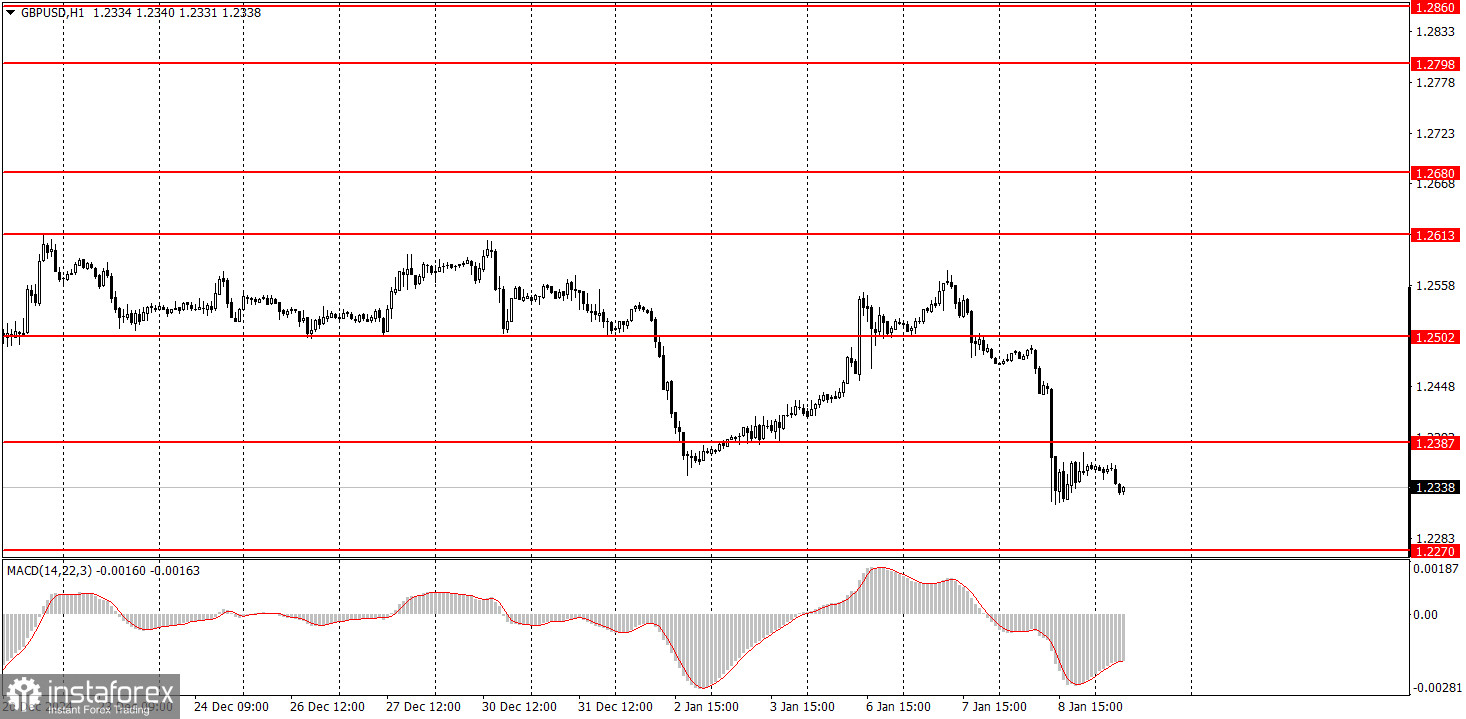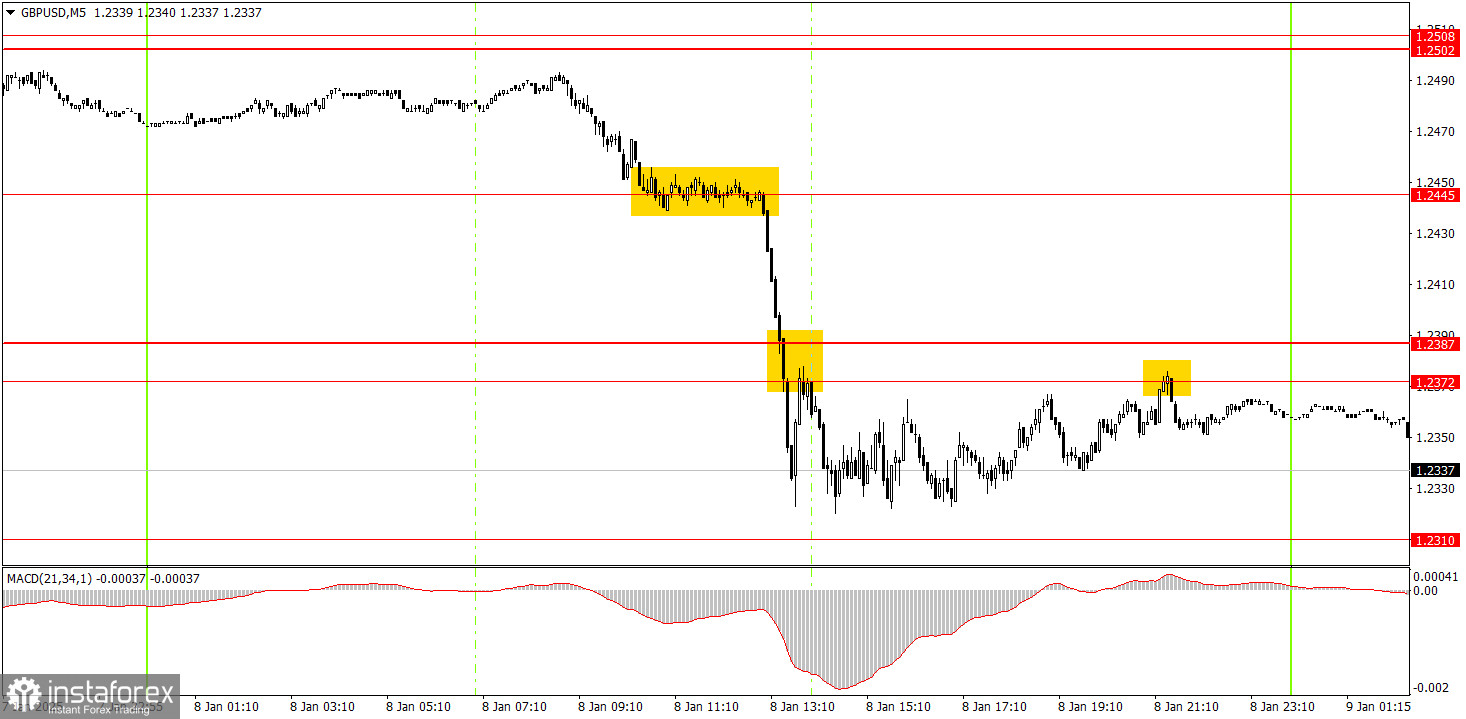Analysis of Wednesday's Trades
1H Chart of GBP/USD

The GBP/USD pair didn't just decline on Wednesday; it experienced a significant plunge. There were even fewer local factors influencing this movement compared to the EUR/USD pair. However, in the medium term, the pound sterling is expected to continue its downward trajectory. We regularly discuss the medium-term outlook in our fundamental articles. The factors contributing to the decline of both the euro and the pound have remained consistent for the past six months. Therefore, for some, the movement observed yesterday may have seemed unusual or illogical, but in reality, there is nothing perplexing about it. Even the weak ADP report in the U.S. did not deter buyers of the U.S. dollar. Consequently, the pair broke through its last local low and has not yet shown a clear rebound that would suggest a potential period of stability. As it stands, it seems that the pound's decline may continue today.
5M Chart of GBP/USD

On the 5-minute timeframe on Wednesday, three strong sell signals were generated. The first signal appeared around the 1.2445 level, after which the pair dropped by more than 100 pips. Following that, the price broke through the 1.2372-1.2387 range and then bounced off this same area. As a result, novice traders could have manually closed their short positions at any point or opted to keep them open, as the likelihood of further decline toward the 1.2310 level remains high.
Trading Strategy for Thursday:
On the hourly timeframe, the GBP/USD pair has moved out of the New Year's flat phase and resumed its primary downtrend. In the medium term, we fully support the decline of the pound, as we believe this is the most logical scenario. Therefore, we should expect sustained downward movement, always relying on technical signals.
On Thursday, the GBP/USD pair is likely to continue the decline that began two days ago, as sell signals are currently being formed. The macroeconomic backdrop today is expected to be weak.
On the 5-minute timeframe, the current trading levels include 1.2387, 1.2445, 1.2502-1.2508, 1.2547, 1.2633, 1.2680-1.2685, 1.2723, 1.2791-1.2798, 1.2848-1.2860, 1.2913, and 1.2980-1.2993. No significant or noteworthy events are scheduled for Thursday in either the UK or the U.S. Consequently, today's movements are expected to be weak and range-bound. However, we believe the pound may continue to decline since the market currently doesn't require much incentive to sell the currency.
Core Trading System Rules:
- Signal Strength: The shorter the time it takes for a signal to form (a rebound or breakout), the stronger the signal.
- False Signals: If two or more trades near a level result in false signals, subsequent signals from that level should be ignored.
- Flat Markets: In flat conditions, pairs may generate many false signals or none at all. It's better to stop trading at the first signs of a flat market.
- Trading Hours: Open trades between the start of the European session and the middle of the US session, then manually close all trades.
- MACD Signals: On the hourly timeframe, trade MACD signals only during periods of good volatility and a clear trend confirmed by trendlines or trend channels.
- Close Levels: If two levels are too close (5–20 pips apart), treat them as a support or resistance zone.
- Stop Loss: Set a Stop Loss to breakeven after the price moves 20 pips in the desired direction.
Key Chart Elements:
Support and Resistance Levels: These are target levels for opening or closing positions and can also serve as points for placing Take Profit orders.
Red Lines: Channels or trendlines indicating the current trend and the preferred direction for trading.
MACD Indicator (14,22,3): A histogram and signal line used as a supplementary source of trading signals.
Important Events and Reports: Found in the economic calendar, these can heavily influence price movements. Exercise caution or exit the market during their release to avoid sharp reversals.
Forex trading beginners should remember that not every trade will be profitable. Developing a clear strategy and practicing proper money management are essential for long-term trading success.





















